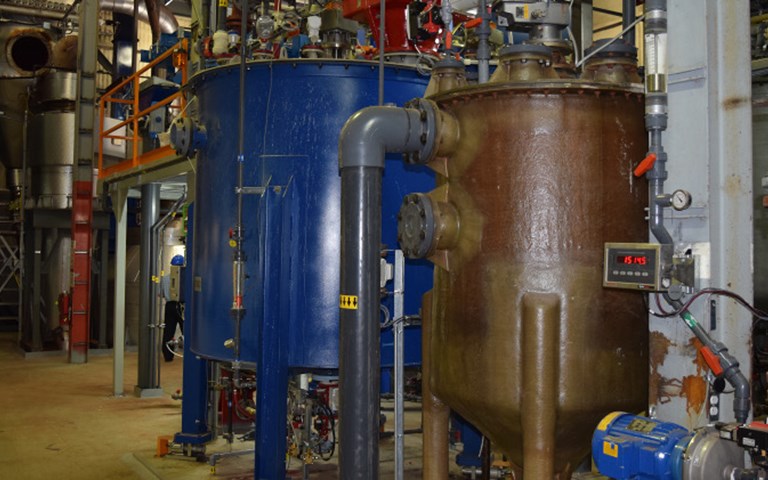Dundee Sustainable Technologies’ recently commissioned demonstration plant is capable of processing 15 tonnes per day of gold concentrate. Courtesy of Dundee Sustainable Technologies
Dundee Sustainable Technologies (DST) is ratcheting up its efforts to create a cyanide-free gold extraction process.
In early July the company commissioned an industrial-scale demonstration plant in Thetford Mines, Quebec, capable of processing up to 15 tonnes per day of gold concentrate using its proprietary chlorination process. The plant will produce about 10,000 ounces of gold under continuous operating conditions over the next two years to demonstrate the effectiveness of the process and identify any potential problems.
The first lot of material to be processed is a gold/copper sulphide concentrate from the Chelopech mine in Bulgaria, operated by sister company Dundee Precious Metals. After that, the company is planning to move into oxide and sulphide ores it sourced from various North and South American regions such as Canada’s Abitibi gold belt and Argentina’s San Juan province.
“Our approach is based on a historical chlorination process that’s been modernized to be much more effective and efficient,” said Jean-Marc Lalancette, the developer of the technology and the company’s chairman. “And it comes at a perfect time for the industry.”
Growing concern around the world surrounding the short- and long-term environmental effects of cyanide use have led to the chemical’s outright ban in many mining jurisdictions, such as the U.S. states of Montana and Wisconsin, and a number of Argentine provinces. “However, with this process, waste only comes in the form of barren and inert solids, meaning there are no acidic tailings to worry about,” said Lalancette. “It safely meets every single environmental regulation in the world.”
The project received a $700,000 grant from the Quebec government in 2011, and $5 million from the federal government in 2013.
Related: Goldcorp’s El Sauzal gold mine in Mexico becomes the first mine decommissioned under the International Cyanide Management Code
Chlorination works quickly, explained DST executive vice-president David Lemieux, with a reagent contact time of only one to two hours rather than the days required by cyanidation. It can also economically treat low-grade base metals, which otherwise require copious amounts of cyanide to extract, and refractory ore, all while consistently hitting similar gold recovery rates at 94 per cent.
“The process requires very little water because almost all of the effluents are recycled, and the mild conditions in the vat leaching reactors make energy costs much lower than cyanidation,” said Lemieux. “The plant itself is also smaller than conventional leaching facilities and can be built in a modular manner. All of that makes the economics very good.”
Closing the loop
To achieve those results, a number of improvements to the original chlorination approach were needed. The chemical process, which involves adsorbing precious metals in highly reactive chlorine gas and then reducing the product to a metallic state, was first introduced in 1848 but faced two significant challenges: the high cost of reagents and the efficiency of precious metal recovery.
“The best way to describe all of the advancements that address those problems is that we’ve managed to completely close the circuit,” said Lemieux. With a closed circuit, DST is able to fully recycle both reagents – namely chlorine and bromine – and water from the barren brine after the ore is leached, substantially cutting down on costly reagent replacements and leaving only solid residue that is much easier to deal with than liquids.
Modern chemical engineering played the biggest role in closing the loop. Instead of using a free halogen like chlorine right off the bat to leach the ore, the company found that sodium hypochlorite, as a hypohalide, could be effectively regenerated and reused continuously through a simple electrolysis step it developed.
Related: EnviroLeach and Mineworx team up to develop e-waste processing plant with an environmentally sound extraction process
While hypohalides do not adsorb precious metals in the same way as halogens, the cheap and readily available chemical compound does generate chlorine and bromine gas when exposed to acidic elements.” This means that all we need to do is add sulphuric acid to the sodium hypochlorite in the vat leaching reactor to provide the necessary reagents, including catalytic amounts of bromine that react extremely quickly with gold, to leach the ore,” said Lemieux.
From the reactor, the pregnant brine goes through a standard three-step process of filtration, adsorption and melting to produce the precious metals, leaving behind acid-free solid waste and a solution of sodium chloride and bromide.
“The regeneration of the hypochlorite from the solution to be fed back into the reactor with the next cycle is the critical step in the process and the second half of the closed circuit,” said Lemieux. The electrolysis cell used at this step is similar to standard cells used in the alkaline industry, with one prominent difference: it has no membrane. The cell is, therefore, much more resistant to contaminants like calcium and magnesium and requires no brine pre-treatment other than a simple pH adjustment and precipitation.
The company has solidified plans to establish facilities similar to its Quebec demonstration plant in South America in the near future, after receiving federal government backing earlier this year for a 200-tonne-per-day concentrator in Chile and provincial support for the process in Argentina’s San Juan province.




